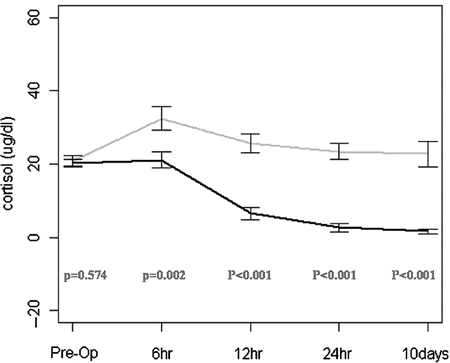ICEECE2012 Poster Presentations Neuroendocrinology (83 abstracts)
Evaluation of cushings disease remission and serum cortisol dynamic early after transsphenoidal surgery
T. Rodrigues 1, , F. Costenaro 1 , G. Rolim 1 & M. Czepielewski 1,
1Universidade Federal do Rio Grande do Sul, Porto Alegre, Brazil; 2Hospital de Clínicas de Porto Alegre, Porto Alegre, Brazil.
Aim: serum cortisol dynamic after transsphenoidal pituitary surgery (TSS) in predicting remission and recurrence of CD.
Methods: A cohort of 103 CD patients from a referral center was prospectively analyzed at 111 TSS in 6.0±4.8 years of follow-up. Twenty patients received glucocorticoids in transoperative and had serum cortisol measured at 10–12 days after TSS (Protocol I). Eighty six patients had serum cortisol measured at each 6 h in the first 24 h, at 48 h and 10–12 days after TSS and glucocorticoid administration only if adrenal insufficiency (Protocol II).Remission (defined as clinical hypercortisolism absence plus serum cortisol < 3 μg/dl in overnight dexamethasone test and/or normal free urinary cortisol) during follow-up and recurrence (loss of remission criteria at least a year after TSS.
Results: Eighty percentage of remission after first TSS, and 8% of the patients had recurrence Serum cortisol nadir ≤3.5 μg/dl at 48 h after TSS had specificity of 100% and sensitivity of 73%, and serum cortisol nadir ≤5.7 μg/dl at 10–12 days after surgery had specificity of 100% and sensitivity of 92% in predicting surgery remission.
Conclusion: Recurrence could not be predicted. These results state the importance of serum cortisol values after TSS in predicting CD remission.
Relative risk for postoperative cortisol as Cushing’s disease predictor, in different adjusted models.
The curve of the postoperative serum cortisol for the remission and failure group after transsphenoidal pituitary surgery.
| RR | CI 95% | P | |
| Model 1 Nadir 48 h PO | 0.90 | 0.84–0.98 | 0.0016 |
| Model 2 Nadir 48 h PO | 0.89 | 0.83–0.96 | 0.003 |
| Model 3 Nadir 48 h PO | 0.90 | 0.83–0.97 | 0.009 |
| Model 4 Nadir 48 h PO | 0.86 | 0.76–0.96 | 0.011 |
| Model 5 Nadir 48 h PO | 0.90 | 0.83–0.96 | 0.004 |
| Model 1 Nadir 10–12 days PO | 0.91 | 0.83–1.0 | 0.063 |
| Model 2 Nadir 10–12 days PO | 0.88 | 0.80–0.96 | 0.005 |
| Model 3 Nadir 10–12 days PO | 0.89 | 0.81–0.97 | 0.008 |
| Model 4 Nadir 10-12 days PO | 0.77 | 0.58–1.0 | 0.069 |
| Model 5 Nadir 10–12 days PO | 0.88 | 0.81–0.96 | 0.004 |
| Model 1, adjustment for microadenoma or macroadenoma in pituitary image; model 2, adjustment for normal pituitary image; model 3, adjustment for presence of adenoma at histopathology; model 4, adjustment for presence of adrenocortotrophic hormone at immunohistochemistry; model 5, adjustment for presence of hypopituitarism after transsphenoidal surgery. | |||
Declaration of interest: The authors declare that there is no conflict of interest that could be perceived as prejudicing the impartiality of the research project.

Funding: This research did not receive any specific grant from any funding agency in the public, commercial or not-for-profit sector.




